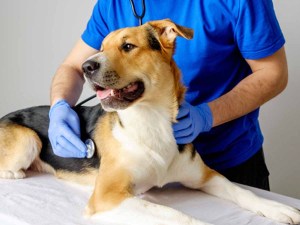Your pet can get skin infections a number of ways. Bacterial and yeast infections can occur when your pet’s skin is damaged because of another skin disorder, such as an injury or allergies.1-3
Bacterial infections
Bacterial infections can occur when your dog or cat has a wound that breaks the skin. Animal bites are a common way that your pet can get a bacterial infection. Some symptoms of a bacterial infection include3:
● Itchiness and/or loss of hair
● Swollen lesions or pustules
● Crusty skin or dried discharge
Although uncommon, untreated bite wounds can cause more serious infections of the joints, bones, or chest cavity.4
Bacterial skin infections in dogs and cats (wounds, abscesses) can be treated with an antibiotic such as Orbax® (orbifloxacin). This is a once-a-day antibiotic. It is available in easy-to-break color-coded tablets and an oral palatable suspension. The oral suspension makes it easy to administer the antibiotic to cats.
Quinolones have been shown to cause arthropathy in immature animals. In animals with known or suspected CNS disorders, quinolones have been associated with CNS stimulation, which may lead to convulsive seizures. The use of fluoroquinolones in cats has been reported to adversely affect the retina and should be used with caution.
Please see the Package Insert for full prescribing information.
Yeast infections
Yeast infections to the skin (yeast dermatitis) are caused by a fungus ordinarily found on your pet’s skin.5 If your pet’s skin produces more oils than usual, if there are allergies, or if its immune system is weakened, the yeast organisms can increase and cause an infection.5 Signs of a yeast skin infection include5:
● Darkening or toughening of skin
● Crusty, flaky skin or scales
● Itchiness or redness
● Chronic ear infections
Your veterinarian may recommend antifungal medication to treat yeast skin infections. Some dog breeds that commonly get yeast skin infections include Terriers, Chihuahuas, Poodles, Basset Hounds, Cocker Spaniels, and Dachshunds.5
Mange
Mange is a skin infection caused by mites that is characterized by itchy patches of skin, sores, and loss of hair.
Sarcoptic mange (Sarcoptes scabiei), also known as canine scabies, is caused by microscopic mites that overpopulate the skin of your dog. This causes intense itchiness, hair loss, sores, and scabs.6 Sarcoptic mange can be passed to humans and can cause a reddish, bumpy rash.6
Demodectic mange mites (Demodex canis) are passed from a mother to her puppies and exist on your dog’s skin his or her entire life. They usually do not cause a problem. However, if these mites overpopulate 1 or 2 areas on your dog’s skin, your dog can lose hair and get scaly patches, or sores.6 It is extremely rare for these mites to be transferred to humans.6
Mange is very uncommon in cats, though sarcoptic mange and notoedric mite (feline mite) and demodectic mites can occur. As in dogs, these mites can cause severe infection and lead to intense itchiness and hair loss.7
What is a hot spot?
Also known as “acute moist dermatitis,” these hot, moist skin irritations are usually caused by allergies, poor grooming, or insect bites – or can be a sign of an infection. Since scratching and licking of irritated areas make hot spots bigger, use an Elizabethan collar (e-collar) on your pet while it’s clearing up!
References:
1. Dog Grooming Tips. ASPCA. https://www.aspca.org/pet-care/dog-care/dog-grooming-tips
2. Cat Grooming Tips. ASPCA. https://www.aspca.org/pet-care/cat-care/cat-grooming-tips
3. Pyoderma in Dogs. PetMD. https://www.petmd.com/dog/conditions/skin/c_multi_pyoderma
4. Bite Wounds in Dogs. VCA Animal Hospitals. https://vcahospitals.com/know-your-pet/bite-wounds-in-dogs
5. Yeast Dermatitis in Dogs. VCA Animal Hospitals. https://vcahospitals.com/know-your-pet/yeast-dermatitis-in-dogs
6. Dog Care. ASPCA. https://www.aspca.org/pet-care/dog-care
7. Cat Care. ASPCA. https://www.aspca.org/pet-care/cat-care
8. Dog Grooming Tips. ASPCA. https://www.aspca.org/pet-care/dog-care/dog-grooming-tips
Want to share this article?
More like this
September is dog tick season
The weather is beautiful, fall is just around the corner … and it’s peak season for ticks.
Tick talk
Use our tick identifier to select a tick and learn about what it looks like, where it lives, and what risks it might pose to your pet.
Caring for a senior pet
Cats and dogs may need special attention as they age, so it helps to understand what to expect as your pet gets older.





 Go To United States
Go To United States Austria
Austria Belgium
Belgium Czech Republic
Czech Republic Denmark
Denmark Europe
Europe Finland
Finland France
France Germany
Germany Greece
Greece Hungary
Hungary Ireland
Ireland Israel
Israel Italy
Italy Netherlands
Netherlands Norway
Norway Poland
Poland Portugal
Portugal Romania
Romania Spain
Spain Sweden
Sweden Turkey
Turkey United Kingdom
United Kingdom